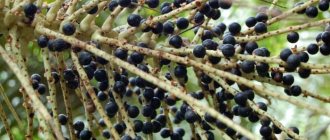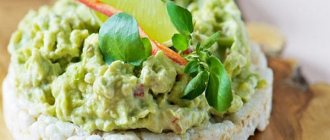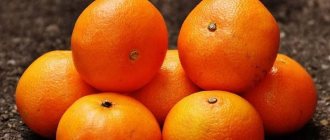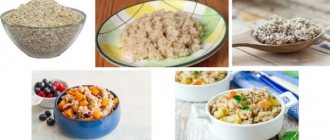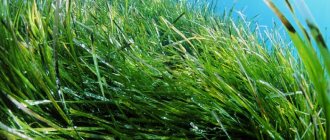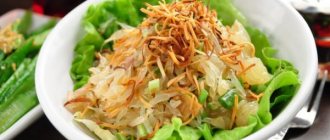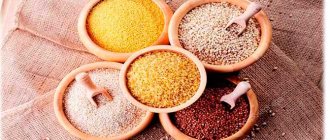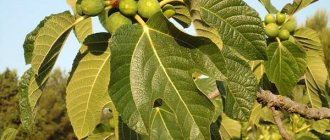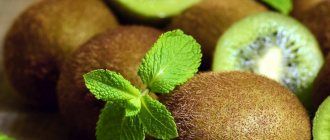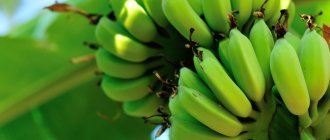Quince is a healthy fruit of the rose family, which is considered to be a relative of pears and apples. The birthplace of the oldest plant is Azerbaijan. In Russia, quince is still considered an exotic plant. The fruits are widely used in cooking and traditional medicine. They have a tart, sweet and sour taste and a pleasant aroma.
Quince is used to make jams, marmalade, juices, compotes, preserves, purees, and even added to meat dishes. The fruits are consumed raw, stewed and boiled. They are also used to make medicinal decoctions and infusions, which are used in folk medicine to treat many diseases.
- For diseases of the digestive system
- Adults During pregnancy and breastfeeding
Chemical composition and calorie content of quince
The benefits of quince are due to its rich chemical composition. The fruit contains:
- vitamins: group B (1,2,6,9), C, A, E, PP;
- minerals: calcium (Ca), potassium (K), magnesium (Mg), phosphorus (P), sodium (Na), iron (Fe), cobalt (Co);
- sugars: glucose, fructose, sucrose;
- tannins and nitrogenous substances;
- pectins;
- slime;
- organic acids: malic, tartaric, citric;
- essential oil;
- nitrogenous substance;
- phytoncides;
- ash;
- starch;
- fatty oil;
- water.
Quince has an average calorie content: about 50 kcal per 100 g of product. Quince BJU: carbohydrates are 960 mg, proteins - 600 mg, fats - 500 mg, vegetable fiber - approximately 360 mg.
Quince varieties
Garden quince has about 400 varieties. About 40 of them are grown in our country alone. Among the popular varieties of quince are the following:
- Muscat – an early variety that produces medium-sized spherical fruits. Quinces of this variety have a ribbed surface and juicy pulp with small grains.
- Gold of the Scythians is an early ripening variety with bright yellow round fruits. The pulp of this quince has a very strong characteristic odor and a sweet and sour taste.
- Krasnoslobodskaya is a medium-ripening variety with large, weighing up to 400 g, fruits that look like an apple.
- Zabutlinskaya is one of the largest-fruited quince varieties, bred by breeders in Dagestan. The fruits of this variety can weigh up to 800 g. They are stored for a long time and tolerate transportation well.
Popular varieties of quince
In total, there are more than 400 varieties of this plant in nature. They differ in the time of flowering and fruiting, the size of the flowers, the structure of the leaves, the shape of the fruit, as well as beneficial properties.
Anzherskaya
The plant produces large yellow fruits with a lemon tint, weighing 400 g. This is the most delicious variety of quince. The fruit has a smooth skin and a ribbed surface.
Quince is used in the treatment of throat diseases, cleanses the body of toxins, stimulates peristalsis and eliminates bleeding gums. Angers quince juice is indicated during pregnancy as an effective remedy for heartburn.
Ordinary
The fruits are covered with a dense, fleecy, lemon-colored peel. They can be spherical or pear-shaped. The pulp of the fruit is hard, dry, astringent and has a sweetish taste. There are many seeds inside the fruit. The fruit can be consumed fresh, baked or canned.
This variety is a leader in the content of nutrients. Common quince is used to prevent eye diseases and treat gastrointestinal diseases, helps get rid of helminthiasis and is an effective laxative. The fruit has a softening and regenerating effect, cleanses the body well, improves cardiac activity and strengthens the immune system.
Japanese Chaenomeles
The plant is distinguished by dense bronze foliage, which subsequently acquires a rich dark green color. The fruits of Japanese quince are yellow with green spots.
The fruits contain a lot of pectin and iron. Thanks to this composition, the fruit is used to remove toxic compounds from the body. Quince restores strength after serious illnesses, is used for chronic fatigue syndrome and has the ability to lower blood sugar.
Chinese quince
Quince blooms with pink or white flowers, 0.05 m in diameter, and has apple-like oval or spherical fruits containing a large number of seeds. The weight of the fetus can reach more than 0.5 kg.
A distinctive feature of this variety is the increased concentration of essential oil in the fruits and a high percentage of vitamin C. The fruits are rich in iron, pectin, citric and malic acid. They regulate the activity of the nervous system, control brain activity, normalize sleep and improve memory.
What is quince
Breeders have created 400 varieties from two types of quince trees: common quince and Japanese quince. Quince varieties differ in flower shape and fruit structure, but otherwise are very similar. The fruit of Cidonia is a false apple covered with a fine pile, which has the following characteristics:
- fruit shape is pear-shaped or round;
- yellow color (one side may have a red tint);
- the surface of the fruit is pubescent, with uneven relief;
- hard, dense pulp with a tart, sweet taste;
- inside the fruit there are 50 to 70 seeds;
- has an apple aroma with light pine notes;
- On average, the weight of the fruit is up to 50 g.
There are numerous varieties of quince fruits, but despite the benefits, the fruit is practically not eaten fresh due to its astringency. Desserts are prepared from healthy “golden apples,” which are popular due to their aromatic smell and delicate taste. Jams, jams, candied fruits and marmalade are not a complete list of quince desserts. One way to eat fruit is to boil it for a short time (20 minutes).
The Quita tree blooms throughout May-June, and mature “golden apples” hang from the branches in September-October. The most famous varieties of quince, which are the most useful, are ordinary, Chinese, Japanese, Angers. It is these varieties that are most often found in the gardens of summer residents and on industrial plantations.
Where does quince grow?
Cidonia received its name in Ancient Greece. Quince culture is quite ancient and dates back 4,000 years. Where does quince come from? It is believed that the quit tree inhabited the regions of Transcaucasia and Central Asia. Common quince is found in the wild in these parts to this day. The natural distribution area covers a large area from Central Asia, central and southern regions of Europe. Cidonia is cultivated on plantations in Europe, America, Oceania and Australia.
Fruits are exported to Russia in the fall from the countries of Central Asia, Moldova, and Transcaucasia. It is best to buy during this period, before they are subjected to additional processing.
Beneficial features
The rich vitamin composition allows the fruit to be used to treat colds of viral and bacterial etiology. In addition, quince:
- helps reduce intoxication in case of poisoning;
- improves liver activity;
- helps reduce blood cholesterol levels;
- eliminates signs of anemia;
- relieves symptoms when stomach problems occur and is an effective remedy for anemia;
- has diuretic properties, helps fight swelling.
Infusions from quince seeds have an enveloping and antiseptic effect and are successfully used as lotions for eye diseases, as well as to relieve inflammation and reduce cough during colds.
For diseases of the digestive system
A positive effect on the organs of the digestive system is achieved due to the presence of tannins in quince. Despite the sufficient amount of fiber, the fruit has a binding effect. Therefore, it can be used for gastrointestinal disorders, especially diarrhea and flatulence.
In folk medicine, not only the pulp of the plant is used, but also the leaves and seeds from it. A laxative decoction is prepared from them, which helps with long-term constipation.
For disorders of the cardiovascular system
It is useful to eat quince for people with cardiac disorders. Due to the presence of large amounts of potassium in the fruits, they are indicated in the treatment of hypertension and functional disorders of the nervous system, and help cope with stress, as they have a calming effect.
The fruits of the exotic plant are used to prevent cancer and various diseases of the cardiovascular system. They are useful for people who are obese, since the fruit contains very little glucose. In addition, thanks to its diuretic properties, quince can be used to remove excess fluid from the body.
Dietary properties:
How many calories are in quince, what dietary properties it has, all this is of great interest to those who lead a healthy lifestyle and monitor their health and figure. So we will try to answer these questions in the next article.
So:
Quince is a shrub or tree 1.5–7 m high, of the Rosaceae family. Quince grows in the south of European Russia. Quince fruits are used for medicinal purposes.
Its fruits contain up to 12% fructose, glucose and sucrose, a small amount of malic, tartaric and citric acids, pectins, tannins, as well as ascorbic acid, some trace elements, in particular iron and copper.
Quince in the diet of people of different Vorzasts
Quince is useful for all people, but different categories have their own characteristics.
Adults
Japanese pear is a healthy fruit for adults and the elderly. Tea made from the fruits and seeds of this plant improves immunity, helps aging people eliminate swelling due to diseases of the cardiovascular system, cleanses the liver, improves peristalsis and is used as a general tonic and antioxidant.
The seeds help women cope with the symptoms of menopause. It is recommended to use fruit juice to treat hemorrhoids. Quince fruits reduce blood cholesterol levels, relieve swelling, help get rid of excess weight and are used to treat many diseases.
During pregnancy and breastfeeding
A woman’s diet during pregnancy should include a sufficient amount of vitamins and microelements, since the health of the unborn baby depends on this. It is important for expectant mothers to eat plenty of fruits and vegetables, especially fresh ones. I am one of them
The fruit is a source of useful substances: copper, iron, potassium, calcium, phosphorus, pectin, etc. Expectant mothers are recommended to eat quince three times a week. This way you can avoid stomach clogging and swelling under the eyes.
Quince helps prevent anemia in the fetus, eliminates symptoms of toxicosis, restores blood circulation, saturates the mother's body with vitamins, strengthens the immune system, and increases the body's resistance. Quince juice and decoctions are absolutely harmless, so pregnant women can use them in the treatment of colds.
Women who are pregnant can eat quince with virtually no restrictions. It is worth considering that this fruit can cause allergies, but this happens extremely rarely.
When breastfeeding, eating quince raw is prohibited. Fruits can cause constipation in a baby and cause allergies. Raw fruits are harmful to the intestines of the youngest mother.
Children
Quince is recommended to be included in the diet of children from a very early age. Raw fruits of this type are too hard and tart for a child’s stomach, which is why they should be given to children only after heat treatment. A child can try the fruit for the first time no earlier than when he is 10 months old and only if he does not have a tendency to allergies or problems with the gastrointestinal tract.
Boiled or baked fruit in the amount of half a teaspoon should be introduced into the baby’s diet, after which the child’s condition should be monitored for two days. In the absence of manifestations of food allergies and constipation, quince can be prepared twice a week, gradually increasing the portion from 5 to 50 grams.
If digestive problems occur, the fruit will have to be excluded from the diet.
An attempt to introduce a vitamin product into the diet can be repeated after a couple of months. The best option for a baby would be quince fruit compote. The drink is absorbed quite well, does not irritate the throat and does not cause a sore throat.
Raw fruits can be given to children starting from the age of two. Before doing this, they should be washed well, peeled and seeds selected. Quince seeds contain a substance - the glycoside amygdalin, which has a toxic effect. Under no circumstances should it be allowed to enter the baby’s stomach, as it can cause poisoning of the body. The villi on the skin of the fruit irritate the laryngeal mucosa, and their use can lead to a prolonged cough.
Contraindications to the use of quince are:
- pleurisy;
- bowel dysfunction;
- individual intolerance of the body.
When buying quince for children, you should choose unrotten, ripe and large fruits, with a uniform yellow color, without dents or green spots on the surface.
Fresh
Quince is an unusual fruit, which in its raw form is practically inedible and is even considered harmful to the digestive tract. Therefore, most often it is boiled before use, as a result of which the pulp becomes soft and tasty. But simultaneously with the increase in taste and gastronomic qualities after cooking, the calorie content of quince also increases - up to 60 kcal per 100 grams. If desired, you can also eat it raw, but for this, the fruit must be completely ripe and rest for 3 weeks after picking for early varieties and about 2 months for late varieties.
Important! Quince seeds contain the substance amygdalin, characteristic of most stone fruits, which causes a lot of controversy about its benefits and harm to the human body. Therefore, before eating or cooking, it is recommended to remove the seed from the fruit.
At its core, amygdalin is vitamin B17, which is not particularly dangerous. But when heated in water, its molecule breaks down into parts, the most dangerous of which is hydrocyanic acid. On the one hand, bones containing amygdalin are considered in folk medicine to be an effective anticancer agent. On the other hand, such properties of this compound have not been confirmed by numerous laboratory studies, and the use and distribution of the substance is prohibited by the US Food and Drug Administration (FDA). Although such a ban did not put an end to the use of vitamin B17, and supporters of alternative medicine argue that pharmaceutical companies deliberately lobby the FDA so as not to lose a huge part of their own profits.
Thus, both statements regarding the fact that by consuming quince seeds one can either be poisoned or be cured of cancer have no compelling basis. After all, in both cases, you will have to eat too much fruit at one time.
But the presence of fiber and catechins in the composition, as well as the low calorie content of quince during a diet, help you lose weight much faster, while a large amount of vitamins and minerals provides high-quality support for the body in conditions of limited nutrition. In addition, the glycemic index of this fruit is only 35 units, which makes it an excellent component of a therapeutic diet for diabetes, and also allows it to be included in the menu of various weight loss programs based on GI.
Thanks to its unique composition and low calorie content, quince provides a wide range of beneficial effects, including:
- improvement of the digestion process, activation of the gastrointestinal tract;
- eliminating negative consequences and reducing the severity of symptoms of stressful situations or depression;
- improvement of the cardiovascular system;
- stopping internal bleeding;
- reducing the likelihood of healthy cells degenerating into cancerous ones;
- prevention of premature aging;
- acceleration of treatment of colds, flu, ARVI and other viral diseases;
- getting rid of anemia and vitamin deficiency, replenishing the need for vitamins and minerals;
- improvement in sclerosis, hypertension, pancreatitis, asthma;
- elimination of gastrointestinal disorders, mild diuretic effect.
This fruit is widely used by traditional healers as an excellent antipyretic to reduce body temperature during inflammatory processes and other diseases. In addition, quince pulp has a pronounced antiseptic effect, which further increases the advisability of use in the treatment of these diseases. And along with the astringent and diuretic properties, the fruits of the plant help to quickly cope with cystitis.
Important! Regular consumption of quince can relieve mental and emotional stress, reduce the severity of stress, stabilize mood and restore good spirits. Such properties are very important during periods of increased stress on the body, including the period of weight loss or recovery from illness.
The harm of fresh quince can be felt by people whose activities involve stress on the vocal cords (pedagogy, singing, public speaking, etc.). It is also not recommended to consume such fruits if you have constipation or pleurisy.
When choosing high-quality fruits, it is necessary to take into account that they must have a uniform color and moderate, not “stone” density. The presence of damage to the peel will lead to rapid spoilage of the product. A fully ripe fruit is characterized by a delicate aroma and dark red or brown seed color. In conditions of moderate humidity and low temperature (from 0ºС to +4ºС), quince can retain its qualities until spring. Stored in a paper bag in the refrigerator for 2 months.
Quince in weight loss
A weight loss diet with quince is very popular among adherents of a healthy diet. Weight loss is achieved thanks to the laxative, choleretic and diuretic properties of this fruit. It has the ability to improve metabolism, cleanses the intestines well and rids the body of toxins.
The duration of diet therapy is three weeks. This involves complete exclusion from the diet of fatty, fried, salty foods, sweets, as well as cakes and pastries. The consumption of day-old rye bread and other dietary products is allowed. The final result in this case largely depends on the calories consumed.
Sample daily menu:
- Breakfast - porridge from any cereal, one apple and tea from quince fruits and leaves.
- Second breakfast - dried fruits or any nuts.
- Lunch - soup, a small piece of lean meat, quince compote.
- Afternoon snack - a glass of yogurt, kefir, fermented baked milk or a little cottage cheese, any fruit juice.
- Dinner - a dish with stewed quince, a glass of green tea or compote.
The serving size for each meal should not be more than 200 g. For dinner, you should always prepare a quince dish. It can be pureed, stewed or boiled fruit. During treatment, under no circumstances should you eat at night. It is recommended to have dinner no later than 6 pm.
It is highly advisable to combine diet with moderate physical activity.
Dried
Low-succulence quince pulp dries quite quickly and after drying almost completely retains its taste. At the same time, the initial calorie content of quince increases only 2 times - up to 95 kcal/100 g, while for most other dried fruits this parameter increases 3-4 times. The beneficial properties of the product are similarly enhanced, since the concentration of biologically active substances also doubles.
As a result, dried quince with regular dosed consumption allows you to obtain the following positive results:
- cleansing the intestines and the whole body of toxins;
- normalization of metabolism and digestive processes;
- effective strengthening of immune defense;
- increasing resistance to cancer;
- improving blood count, maintaining heart and vascular health;
- treatment of gastrointestinal diseases;
- normalization of the respiratory system;
- relieving headaches and excessive irritability;
- fixative effect for diarrhea;
- pronounced diuretic effect;
- persistent anti-inflammatory effect;
- energy supply during increased physical and mental stress.
In addition to its characteristic beneficial properties, dried quince has some additional effects on the body:
- restores intestinal microflora after prolonged use of antibiotics;
- removes carcinogens, radionuclides, heavy metal salts;
- reduces symptoms of toxicosis and relieves swelling in pregnant women;
- reduces sensitivity to changes in atmospheric pressure and weather changes (the so-called weather dependence);
- quickly eliminates bad breath.
If the correct drying technology is followed with careful removal of lint, dried quince fruits do not cause a sore throat and are not contraindicated for people whose profession involves constant strain on the vocal cords. But due to the increased content of acids in the dried pulp, such a product is not recommended to be introduced into the diet if there are disorders of stomach acidity. Due to its strong strengthening effect, drying can aggravate the situation if you are prone to constipation. And the beneficial effect on the emotional state and nervous system, if the product is abused, can cause harm by having a psychotropic effect.
In cosmetology
Due to the content of a large amount of fruit acids, the fruit is widely used in cosmetology. Masks, creams, balms, lotions and tonics are made from the pulp, leaves and seeds.
Quince pulp helps get rid of acne, nourishes, cleanses and tones the skin, and has regenerating properties. A tonic is made from fruit juice to lighten freckles and eliminate age spots. The fruit is used both in its pure form and as one of the ingredients included in cosmetic products.
Quince: calorie content and nutritional supplements, health benefits and harms, traditional medicine recipes
Fruits
16.01.2018
11.7 thousand
7.8 thousand
6 min.
The healing properties of quince were discovered more than 4 thousand years ago. Decoctions were made from the pulp, seeds and leaves of the plant, which were used to treat viral diseases, diabetes and problems with the digestive system.
In addition to the common quince, varieties cultivated in the East are popular. The Chinese variety contains large amounts of vitamin C, which is why it is popularly called the fruit of longevity.
And in the fruits of Japanese quince, scientists discovered pectin substances that help remove heavy metal salts from the body.
WEIGHT LOSS STORIES OF STARS!
Irina Pegova shocked everyone with her weight loss recipe: “I lost 27 kg and continue to lose weight, I just brew it at night...” Read more >>
Quince is a dietary product. Regular consumption of the aromatic fruit improves digestion and prevents the deposition of fats in the body.
To speed up the process of losing weight, nutritionists advise eating fruit at least three times a week and avoiding fatty foods and sweets.
Energy value and BJU per 100 grams of product.
| Substance | Quantity in fruits | Proportion of the daily value of an adult |
| Squirrels | 0.6 g | 0,7 % |
| Fats | 0.4 g | 0,7 % |
| Carbohydrates | 11 g | 4 % |
| Calories: 48 calories. |
The ripe fruits of the plant contain vitamins C, E, B1, PP, as well as iron, calcium and zinc.
Quince has antioxidant and antiviral properties.
Doctors advise people who want to maintain good health to include it in their diet. The benefits of fruit for the body of an adult and a child are discussed below.
Medicinal properties of quince:
- During heavy periods, doctors advise drinking decoctions from the leaves and seeds of the plant. They stop bleeding and replenish iron deficiency in the female body.
- During pregnancy, the expectant mother should include fresh quince in her diet, as it contains folic acid, which ensures the normal development of the fetus.
- Homemade compote and freshly squeezed juice help reduce symptoms of toxicosis in pregnant women.
- To speed up metabolism and remove excess fluid from the body, it is useful to add a couple of quince cloves to freshly brewed tea.
- You can remove inflammation on the skin using a homemade mask. You need to grate a couple of quince cloves and apply the resulting mixture to your face in an even layer. Keep the mask on for 5 minutes, then rinse with warm water.
The beneficial properties of the fruit are due to its rich composition:
- Vitamin A (retinol) helps prevent prostate cancer in men.
- Ascorbic acid has a beneficial effect on potency and increases sexual desire.
- Niacin regulates the production of the most important male hormone - testosterone.
- Antioxidants reduce the risk of heart attack and stroke, which affect men after 45 years of age.
Fruit can be introduced into a child’s diet from one year of age. It is better not to give it raw to small children. Optimal cooking methods: bake without skin in the oven, cook homemade compote, make fruit or vegetable casserole.
The plant has a positive effect on the physical and emotional state of the child:
- Promotes mental development.
- Increases brain activity and concentration.
- Strengthens the immune system.
- Improves the functioning of the digestive organs.
- Facilitates the progression of viral diseases.
- The chemicals in its composition are involved in the formation of bone tissue.
Excessive consumption of quince can be harmful to health, so you should not eat too much of it. The fruit must be completely excluded from the diet if the following contraindications are present:
- Digestive syndrome - enterocolitis.
- Gastritis.
- Increased stomach acidity.
- Tendency to constipation.
- Pleurisy.
- Tendency to allergic reactions.
Breastfeeding may cause bloating in the baby, so you should consult your doctor before introducing it into your diet.
Quince is used to prepare medicinal decoctions, tinctures and teas.
Directions for use:
- 1. To stop uterine bleeding, you need to pour 20 grams of dried quince with a glass of boiling water. The decoction should steep for an hour. Take 1 tbsp. l. before every meal.
- 2. Diuretic: 1 tbsp. l. Pour a glass of boiling water over the dried leaves and seeds of the plant. Cook in a saucepan over low heat for 5 minutes, then cool and strain through cheesecloth. Drink 1 tbsp. l. three times a day.
- 3. Antipyretic: cut two quinces into slices, after removing the seeds. Pour 1 liter of boiling water over the fruit and leave in a thermos for 1.5 - 2 hours. Drink the infusion in small sips throughout the day.
- 4. Our ancestors used quince juice to treat burns and skin inflammations. They moistened gauze with it and applied it to the affected area.
- 5. For colitis, it is recommended to drink a decoction of quince seeds. Pour 10 grams of plant seeds into a glass of clean cold water, leave the drink overnight to steep. Then strain through cheesecloth and drink throughout the day.
The use of quince to treat children should be discussed with a pediatrician.
After heat treatment, quince retains its properties, so it is widely used in cooking for making desserts, refreshing drinks, sauces for meat dishes and preparations for the winter.
To prepare a delicious quince compote you will need the following ingredients:
- quince – 1.5 kg;
- granulated sugar – 200 g;
- water – 1 l;
- citric acid – 10 g.
Preparation:
- 1. Peel and pit the quince and cut into slices. To prevent the fruit from darkening, it must be immersed in water with the addition of citric acid.
- 2. Boil the fruits until soft in 1 liter of water. Then drain the liquid and place the quince slices in a sterile jar.
- 3. Add sugar to 1 liter of water and boil the syrup for 5 minutes.
- 4. Pour it into jars of fruit. Roll them up, turn them over and cover them with a warm blanket. When the compote has cooled, transfer it to a cool, dark room.
Jam is an excellent alternative to high-calorie baked goods for those who adhere to the principles of a healthy diet. It can be eaten with tea or added to cereals and sandwiches for breakfast.
Classic recipe ingredients:
- quince – 1 kg;
- lemon juice – 100 ml;
- granulated sugar – 600 g;
- water – 0.4 – 0.6 l.
Step-by-step preparation:
- 1. Peel the quince and cut into cubes or slices. Place it in a saucepan, add water and cook after boiling for 20 minutes over medium heat, stirring constantly.
- 2. Add sugar and lemon juice to the quince. Cook for 30 minutes.
- 3. Roll the finished jam into jars and keep warm until it cools. Store the delicious treat in a cool, dark room.
Ingredients:
- quince – 3 pcs.;
- lemon – 1 pc.;
- butter – 50 g;
- granulated sugar - 3 tbsp. l.;
- honey - 3 tbsp. l.
- peeled walnuts – 12 pcs.
For people who are on a diet, this recipe is perfect as a healthy snack. Only sugar and butter need to be removed from it. Quince with honey and nuts saturates the body with energy, increases endurance and strengthens the immune system.
Preparation:
- 1. Peel the quince, remove the core and cut into two halves.
- 2. Cover a baking sheet with foil and grease with butter. Place fruit halves on it.
- 3. Add 1 spoon of honey, a little butter and a handful of finely chopped nuts to each of them.
- 4. Sprinkle with lemon juice, cover with foil and bake in an oven preheated to 190 degrees for 30 minutes. Then remove the foil and bake for another 15 minutes.
- 5. The finished dessert can be sprinkled with cinnamon. It will give the dish an exotic aroma.
The story of one of our readers Alina R.:
I was especially depressed about my weight. I gained a lot, after pregnancy I weighed as much as 3 sumo wrestlers together, namely 92 kg with a height of 165. I thought the belly would go away after giving birth, but no, on the contrary, I began to gain weight.
How to cope with hormonal changes and obesity? But nothing disfigures or makes a person look younger than his figure. At the age of 20, I first learned that plump girls are called “WOMAN”, and that “they don’t make clothes that size.”
Then at the age of 29, divorce from her husband and depression...
But what can you do to lose weight? Laser liposuction surgery? I found out - no less than 5 thousand dollars. Hardware procedures - LPG massage, cavitation, RF lifting, myostimulation? A little more affordable - the course costs from 80 thousand rubles with a nutritionist consultant. You can, of course, try to run on a treadmill until you go crazy.
And when will you find time for all this? And it's still very expensive. Especially now. Therefore, I chose a different method for myself...
Read more >>
Source: https://nadietu.net/dietary-products/fruits/ajva-poleznye-svojstva.html
Contraindications for use
Despite the usefulness of quince, if used incorrectly, it can be harmful to human health. The seeds of the plant should not be crushed or chewed. When they are destroyed, amygdalin is released, the effect of which is enhanced in combination with vitamin C. The substance is toxic and can cause intoxication of the body.
Contraindications to the use of quince are:
- stomach and duodenal ulcers;
- pleurisy, pneumonia;
- chronic constipation;
- allergy to components contained in the fruit;
- diseases of the gastrointestinal tract;
- inflammation of the larynx.
In all other cases, quince is useful, but it is recommended to use it within reasonable limits.
Quince harm and contraindications
Some people may be allergic to quince, although this is rare. Other contraindications are also possible. Fruits are not recommended:
- in the presence of chronic constipation;
- if you are afraid of injuring your vocal cords due to the pubescence on the fruit peel;
- for some problems with the gastrointestinal tract.
Decoctions are prepared from fruit seeds, but in crushed form they are unsuitable for consumption, since the seeds contain the toxic substance amygdalin, due to which the fruit has a slightly bitter almond smell.
The health benefits of quince and its harm are not comparable. You need to listen to the warnings of nutritionists and if there are no side effects, then eat healthy and healthy fruit for your pleasure. There are a lot of recipes with quince desserts; you can come up with your own healthy, original dish. The main thing is desire, imagination and the fruits of the “golden apple”.
Popular folk recipes
There are many proven recipes with quince that can be used to treat various diseases.
| Indications | Recipe | How to use |
| Sore throat and dry cough |
| Strain and take 1/3 cup three times a day before meals |
| Asthmatic attack |
| Take 2 tbsp. l. 4 times a day, regardless of meals |
| Angina |
| Drink 3-4 tbsp of medicine. l. 3 times a day, preferably after meals |
| Anemia |
| Take 3-4 tbsp. l.three times a day for anemia |
Before using folk remedies, it is recommended to consult a specialist.
Use in cooking
Quince is widely used in the food industry in different countries. The aroma of the raw fruit is unusual, but pleasant. It contains notes of tree bark, unripe pear, autumn flowers, and sour apple. Sometimes quince smells like a tropical fruit. It is used to make jams, jellies for afternoon tea, elite white wines “Chenin Blanc”, “Sauvignon Blanc”, “Chardonnay”, marshmallows, candied fruits, marmalade, sauces, gravies for meat dishes. To add a sour taste, quince slices are added to borscht, cabbage soup, soup, pickle soup, baked goods or even tea. In Ancient Greece, the miracle fruit was baked with honey, and in the east it was stuffed with minced beef and beans.
When fresh, the fruit is too hard and contains bitter tannins. But stewed quince is much sweeter, softer and healthier. Prolonged heat treatment gives the Asian fruit a light pink, reddish or deep purple hue.
Before cooking, all seeds are removed from quince, since they contain a poisonous component - amygdalin, which, when ingested, turns into cyanide and leads to poisoning of the body.
Remember, the value of the fruit is in the subtle aroma concentrated in the skin. In Transcaucasia and Central Asia, the pulp of the fruit is added as a seasoning to all national dishes. Meat is stewed with it. Therefore, when preparing quince, to preserve the smell, a very thin layer of shell is removed. In Spain, the fruit is used to make marmalade, which is usually eaten with spicy cheese. In addition, it is used to stuff poultry together with meat and rice.
In Iran, quince is used to prepare canned syrup, which is usually diluted with lime juice or water before use.
Quince fruit diets
How exactly to lose weight on juicy fruits? There are different nutrition programs and diets.
A long-term diet for three weeks involves the exclusion of fatty and sweet foods, as well as baked goods, with the exception of rye or whole grain bread in small quantities. The volume of one serving should be no more than 200 g. Dinner is always a quince dish (any). In the morning and afternoon you should drink tea from these fruits.
Here is a sample diet menu:
· in the morning - any porridge, fruit and quince tea;
Second breakfast - nuts or dried fruits;
· lunch - soup, lean meat, salad and quince drink;
· afternoon snack - cottage cheese or yogurt, juice;
· in the evening - a quince dish and green tea.
The menu can be changed at your discretion, the main thing is to adhere to the basic rules. How to prepare quince tea for a diet? The quince fruits should be dried in the oven at 50 degrees, ground into powder and a tablespoon of this powder should be added to a glass of boiling water. You can drink tea with cinnamon or honey.
Popular articles for weight loss and health
How many calories are spent walking 1 km?
Tatyana Malakhova's diet for weight loss menu
How many calories are in roasted sunflower seeds 100 g
How to lose 10 kg by New Year at home
There is another option for a diet based on quince seeds. You need to brew a teaspoon of seeds with half a glass of boiling water and leave for two hours. You should drink the drink half an hour before each main meal, one tablespoon at a time. The infusion reduces appetite and helps not to overeat. And food during the diet should be low-calorie. Mainly vegetables, fruits, meat, fish and cottage cheese. You should stick to the diet for two weeks.
Composition and nutritional value of the fruit
The nutritional value of the fruit we are considering is as follows:
- proteins – 0.63 g;
- fats – 0.52 g;
- carbohydrates – 9.67 g;
- saturated fatty acids – 0.12 g;
- organic acids – 0.96 g;
- unsaturated fatty acids – 0.11 g;
- dietary fiber – 3.67 g;
- starch – 2.04 g;
- mono- and disaccharides – 7.66 g.
They contain the following vitamins:
- PP – 0.21 mg;
- E – 0.42 mg;
- C – 23.02 mg;
- B2 – 0.25 mg;
- B1 – 0.03 mg;
- A – 169 mcg.
Mineral composition:
- iron – 30.07 mg;
- phosphorus – 24.91 mg;
- potassium – 144.0 mg;
- sodium – 14.08 mg;
- calcium – 14.50 mg.
Quince is also rich in acids necessary for the human body: malic, pectic, citric, tartaric and tartronic.
It turns out that just one fruit helps our body replenish the daily requirement of almost all nutrients
But you should know that the seeds of this fruit contain substances hazardous to health: amygdalin, mucus, tannins and fatty acids, and therefore it should be consumed exclusively without them.
Quince: calorie content, beneficial properties and contraindications, use for weight loss
Quince is a healthy fruit of the rose family, which is considered to be a relative of pears and apples. The birthplace of the oldest plant is Azerbaijan. In Russia, quince is still considered an exotic plant. The fruits are widely used in cooking and traditional medicine. They have a tart, sweet and sour taste and a pleasant aroma.
Quince is used to make jams, marmalade, juices, compotes, preserves, purees, and even added to meat dishes. The fruits are consumed raw, stewed and boiled. They are also used to make medicinal decoctions and infusions, which are used in folk medicine to treat many diseases.
The benefits of quince are due to its rich chemical composition. The fruit contains:
- vitamins: group B (1,2,6,9), C, A, E, PP;
- minerals: calcium (Ca), potassium (K), magnesium (Mg), phosphorus (P), sodium (Na), iron (Fe), cobalt (Co);
- sugars: glucose, fructose, sucrose;
- tannins and nitrogenous substances;
- pectins;
- slime;
- organic acids: malic, tartaric, citric;
- essential oil;
- nitrogenous substance;
- phytoncides;
- ash;
- starch;
- fatty oil;
- water.
Quince has an average calorie content: about 50 kcal per 100 g of product. Quince BJU: carbohydrates are 960 mg, proteins - 600 mg, fats - 500 mg, vegetable fiber - approximately 360 mg.
In total, there are more than 400 varieties of this plant in nature. They differ in the time of flowering and fruiting, the size of the flowers, the structure of the leaves, the shape of the fruit, as well as beneficial properties.
The plant produces large yellow fruits with a lemon tint, weighing 400 g. This is the most delicious variety of quince. The fruit has a smooth skin and a ribbed surface.
Quince is used in the treatment of throat diseases, cleanses the body of toxins, stimulates peristalsis and eliminates bleeding gums. Angers quince juice is indicated during pregnancy as an effective remedy for heartburn.
The fruits are covered with a dense, fleecy, lemon-colored peel. They can be spherical or pear-shaped. The pulp of the fruit is hard, dry, astringent and has a sweetish taste. There are many seeds inside the fruit. The fruit can be consumed fresh, baked or canned.
This variety is a leader in the content of nutrients. Common quince is used to prevent eye diseases and treat gastrointestinal diseases, helps get rid of helminthiasis and is an effective laxative. The fruit has a softening and regenerating effect, cleanses the body well, improves cardiac activity and strengthens the immune system.
The plant is distinguished by dense bronze foliage, which subsequently acquires a rich dark green color. The fruits of Japanese quince are yellow with green spots.
The fruits contain a lot of pectin and iron. Thanks to this composition, the fruit is used to remove toxic compounds from the body. Quince restores strength after serious illnesses, is used for chronic fatigue syndrome and has the ability to lower blood sugar.
Quince blooms with pink or white flowers, 0.05 m in diameter, and has apple-like oval or spherical fruits containing a large number of seeds. The weight of the fetus can reach more than 0.5 kg.
A distinctive feature of this variety is the increased concentration of essential oil in the fruits and a high percentage of vitamin C. The fruits are rich in iron, pectin, citric and malic acid. They regulate the activity of the nervous system, control brain activity, normalize sleep and improve memory.
The rich vitamin composition allows the fruit to be used to treat colds of viral and bacterial etiology. In addition, quince:
- helps reduce intoxication in case of poisoning;
- improves liver activity;
- helps reduce blood cholesterol levels;
- eliminates signs of anemia;
- relieves symptoms when stomach problems occur and is an effective remedy for anemia;
- has diuretic properties, helps fight swelling.
Infusions from quince seeds have an enveloping and antiseptic effect and are successfully used as lotions for eye diseases, as well as to relieve inflammation and reduce cough during colds.
A positive effect on the organs of the digestive system is achieved due to the presence of tannins in quince. Despite the sufficient amount of fiber, the fruit has a binding effect. Therefore, it can be used for gastrointestinal disorders, especially diarrhea and flatulence.
In folk medicine, not only the pulp of the plant is used, but also the leaves and seeds from it. A laxative decoction is prepared from them, which helps with long-term constipation.
It is useful to eat quince for people with cardiac disorders. Due to the presence of large amounts of potassium in the fruits, they are indicated in the treatment of hypertension and functional disorders of the nervous system, and help cope with stress, as they have a calming effect.
The fruits of the exotic plant are used to prevent cancer and various diseases of the cardiovascular system. They are useful for people who are obese, since the fruit contains very little glucose. In addition, thanks to its diuretic properties, quince can be used to remove excess fluid from the body.
Quince is useful for all people, but different categories have their own characteristics.
Japanese pear is a healthy fruit for adults and the elderly. Tea made from the fruits and seeds of this plant improves immunity, helps aging people eliminate swelling due to diseases of the cardiovascular system, cleanses the liver, improves peristalsis and is used as a general tonic and antioxidant.
The seeds help women cope with the symptoms of menopause. It is recommended to use fruit juice to treat hemorrhoids. Quince fruits reduce blood cholesterol levels, relieve swelling, help get rid of excess weight and are used to treat many diseases.
A woman’s diet during pregnancy should include a sufficient amount of vitamins and microelements, since the health of the unborn baby depends on this. It is important for expectant mothers to eat plenty of fruits and vegetables, especially fresh ones. I am one of them
The fruit is a source of useful substances: copper, iron, potassium, calcium, phosphorus, pectin, etc. Expectant mothers are recommended to eat quince three times a week. This way you can avoid stomach clogging and swelling under the eyes.
Quince helps prevent anemia in the fetus, eliminates symptoms of toxicosis, restores blood circulation, saturates the mother's body with vitamins, strengthens the immune system, and increases the body's resistance. Quince juice and decoctions are absolutely harmless, so pregnant women can use them in the treatment of colds.
Women who are pregnant can eat quince with virtually no restrictions. It is worth considering that this fruit can cause allergies, but this happens extremely rarely.
When breastfeeding, eating quince raw is prohibited. Fruits can cause constipation in a baby and cause allergies. Raw fruits are harmful to the intestines of the youngest mother.
Quince is recommended to be included in the diet of children from a very early age.
Raw fruits of this type are too hard and tart for a child’s stomach, which is why they should be given to children only after heat treatment.
A child can try the fruit for the first time no earlier than when he is 10 months old and only if he does not have a tendency to allergies or problems with the gastrointestinal tract.
Boiled or baked fruit in the amount of half a teaspoon should be introduced into the baby’s diet, after which the child’s condition should be monitored for two days. In the absence of manifestations of food allergies and constipation, quince can be prepared twice a week, gradually increasing the portion from 5 to 50 grams.
If digestive problems occur, the fruit will have to be excluded from the diet.
An attempt to introduce a vitamin product into the diet can be repeated after a couple of months. The best option for a baby would be quince fruit compote. The drink is absorbed quite well, does not irritate the throat and does not cause a sore throat.
Raw fruits can be given to children starting from the age of two. Before doing this, they should be washed well, peeled and seeds selected. Quince seeds contain a substance - the glycoside amygdalin, which has a toxic effect.
Under no circumstances should it be allowed to enter the baby’s stomach, as it can cause poisoning of the body.
The villi on the skin of the fruit irritate the laryngeal mucosa, and their use can lead to a prolonged cough.
Contraindications to the use of quince are:
- pleurisy;
- bowel dysfunction;
- individual intolerance of the body.
When buying quince for children, you should choose unrotten, ripe and large fruits, with a uniform yellow color, without dents or green spots on the surface.
A weight loss diet with quince is very popular among adherents of a healthy diet. Weight loss is achieved thanks to the laxative, choleretic and diuretic properties of this fruit. It has the ability to improve metabolism, cleanses the intestines well and rids the body of toxins.
The duration of diet therapy is three weeks. This involves complete exclusion from the diet of fatty, fried, salty foods, sweets, as well as cakes and pastries. The consumption of day-old rye bread and other dietary products is allowed. The final result in this case largely depends on the calories consumed.
Sample daily menu:
- 1. Breakfast - porridge from any cereal, one apple and tea from quince fruits and leaves.
- 2. Second breakfast - dried fruits or any nuts.
- 3. Lunch - soup, a small piece of lean meat, quince compote.
- 4. Afternoon snack - a glass of yogurt, kefir, fermented baked milk or a little cottage cheese, any fruit juice.
- 5. Dinner - a dish with stewed quince, a glass of green tea or compote.
The serving size for each meal should not be more than 200 g. For dinner, you should always prepare a quince dish. It can be pureed, stewed or boiled fruit. During treatment, under no circumstances should you eat at night. It is recommended to have dinner no later than 6 pm.
It is highly advisable to combine diet with moderate physical activity.
Fresh quince fruits are used extremely rarely, as they are quite hard and have a tart taste. But baked and boiled fruits are successfully used in cooking. They are included in various dishes: they make desserts, jellies, marmalade, make preserves, compotes, jams, make candied fruits and add them to fruit juices.
Quince is canned, dried, dried and used as a side dish for meat dishes.
Due to the content of a large amount of fruit acids, the fruit is widely used in cosmetology. Masks, creams, balms, lotions and tonics are made from the pulp, leaves and seeds.
Quince pulp helps get rid of acne, nourishes, cleanses and tones the skin, and has regenerating properties. A tonic is made from fruit juice to lighten freckles and eliminate age spots. The fruit is used both in its pure form and as one of the ingredients included in cosmetic products.
Despite the usefulness of quince, if used incorrectly, it can be harmful to human health. The seeds of the plant should not be crushed or chewed. When they are destroyed, amygdalin is released, the effect of which is enhanced in combination with vitamin C. The substance is toxic and can cause intoxication of the body.
Contraindications to the use of quince are:
- stomach and duodenal ulcers;
- pleurisy, pneumonia;
- chronic constipation;
- allergy to components contained in the fruit;
- diseases of the gastrointestinal tract;
- inflammation of the larynx.
In all other cases, quince is useful, but it is recommended to use it within reasonable limits.
There are many proven recipes with quince that can be used to treat various diseases.
| Indications | Recipe | How to use |
| Sore throat and dry cough |
| Strain and take 1/3 cup three times a day before meals |
| Asthmatic attack |
| Take 2 tbsp. l. 4 times a day, regardless of meals |
| Angina |
| Drink 3-4 tbsp of medicine. l. 3 times a day, preferably after meals |
| Anemia |
| Take 3-4 tbsp. l.three times a day for anemia |
Before using folk remedies, it is recommended to consult a specialist.
Source: https://tonustela.net/calorific-value/fruit-berry/ayva.html
How to choose a quince
In order for the beneficial properties of quince to be fully revealed to the body, you need to choose the right fruits. A good fruit is yellow, round or pear-shaped with hard skin and dense pulp.
When choosing, you should pay attention to the following points:
- the quince should look whole, free from external damage;
- a ripe fruit is completely yellow; if green areas are visible, it means it is not ripe;
- dark spots on the skin are a sign of rotting;
- ripe fruits are very fragrant.
Fruits ripen in autumn and are perfectly preserved until spring, so you can buy and store “false apples” throughout the winter season.
